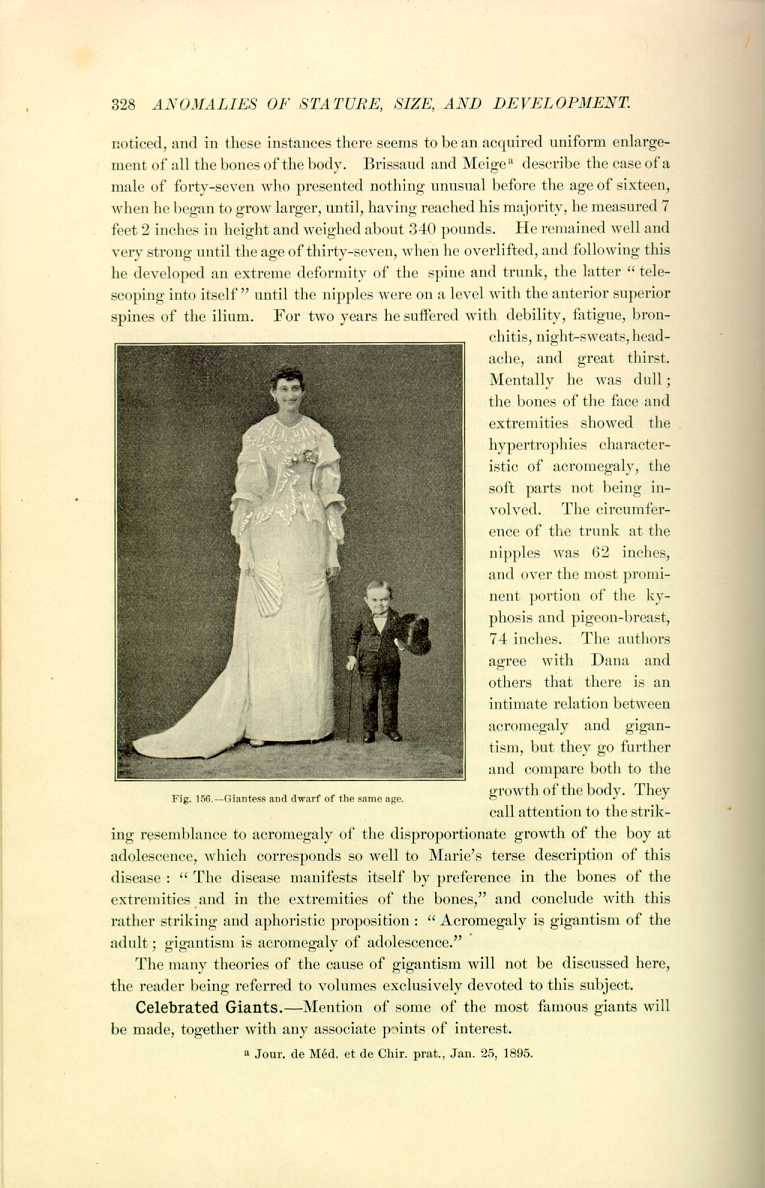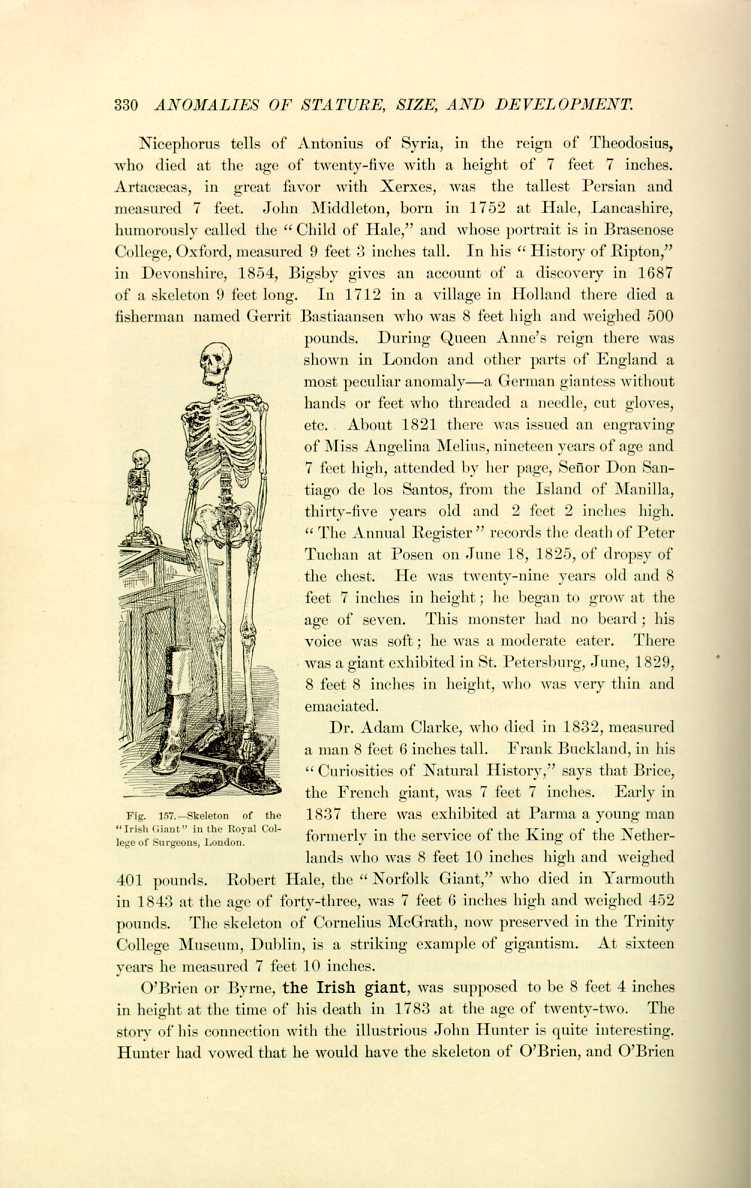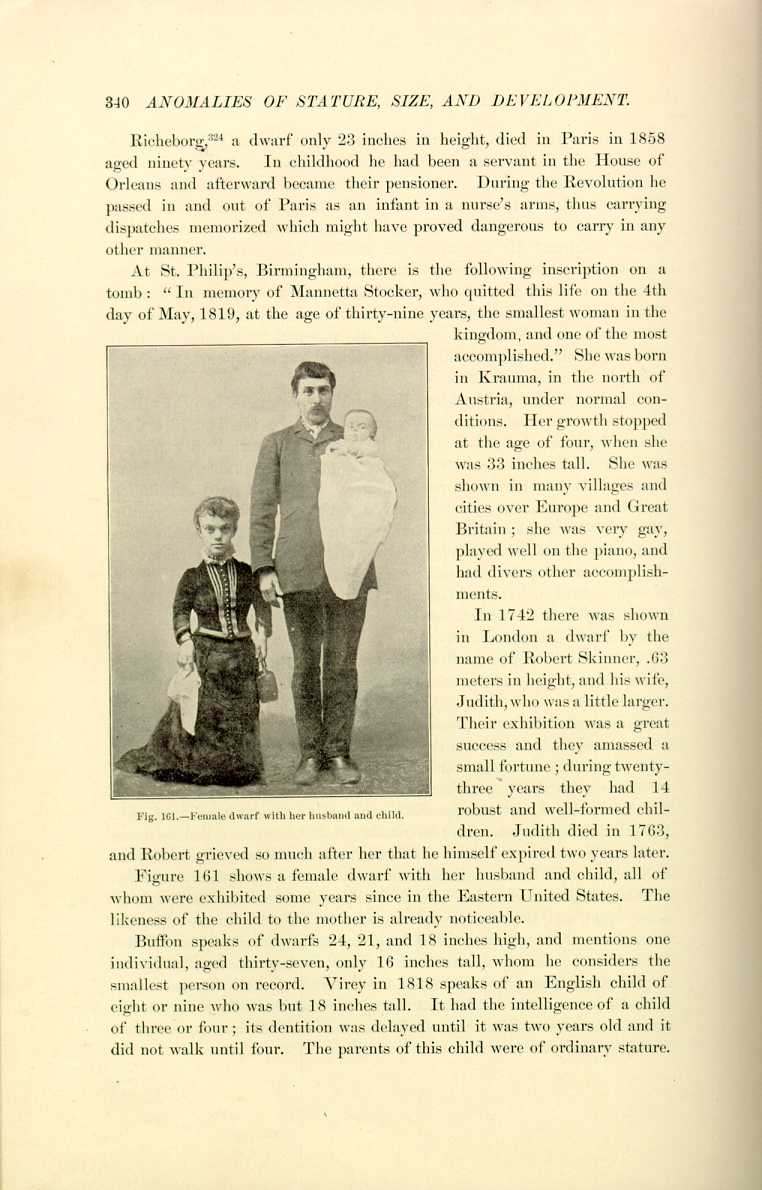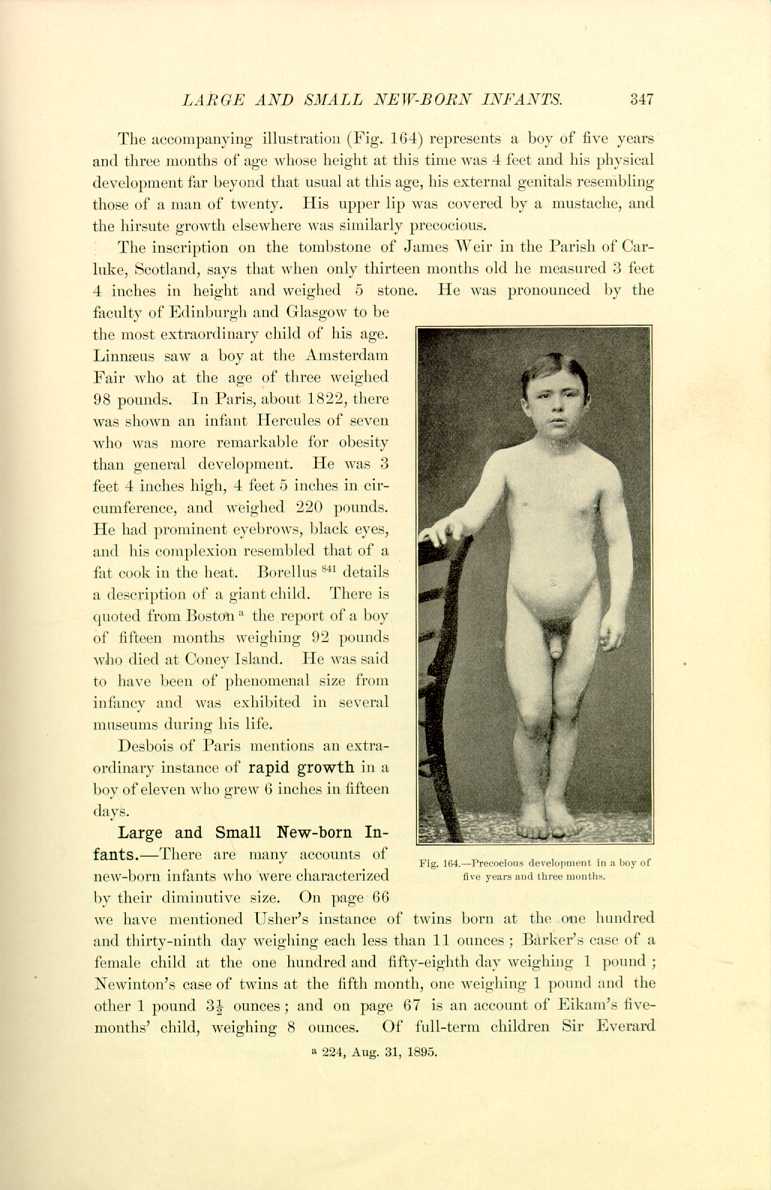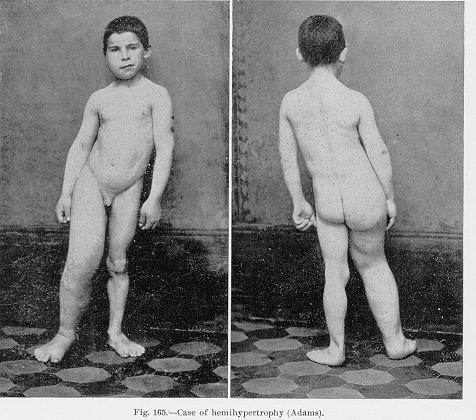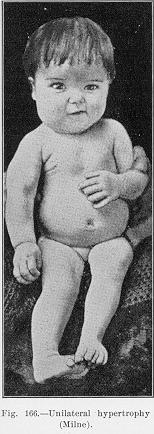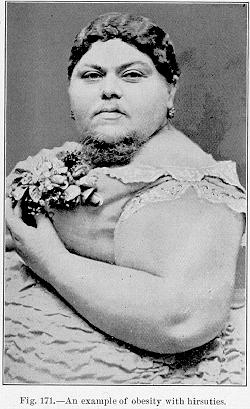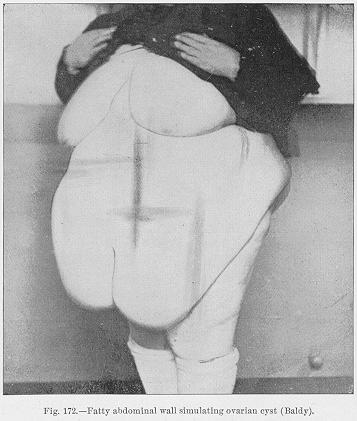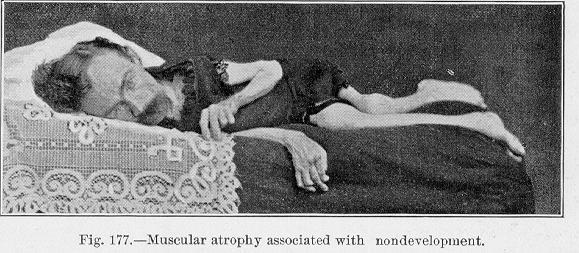| CHAPTER VII.
ANOMALIES OF STATURE, SIZE, AND
DEVELOPMENT. Anomalies and Curiosities of Medicine | ||
7. CHAPTER VII.
ANOMALIES OF STATURE, SIZE, AND
DEVELOPMENT.
Giants.—The fables of mythology contain accounts of horrible monsters, terrible in ferocity, whose mission was the destruction of the life of the individuals unfortunate enough to come into their domains. The ogres known as the Cyclops, and the fierce anthropophages, called Lestrygons, of Sicily, who were neighbors of the Cyclops, are pictured in detail in the "Odyssey'' of Homer. Nearly all the nations of the earth have their fairy tales or superstitions of monstrous beings inhabiting some forest, mountain, or cave; and pages have been written in the heroic poems of all languages describing battles between these monsters and men with superhuman courage, in which the giant finally succumbs.
The word giant is derived indirectly from the old English word "geant,'' which in its turn came from the French of the conquering Normans. It is of Greek derivation, ''γιγας"— or the Latin, "gigas.'' The Hebrew parallel is "nophel,'' or plural, "nephilim.''
Ancient Giants.—We are told in the Bible [7.1] that the bedstead of Og, King of Basham, was 9 cubits long, which in English measure is 16 1/2 feet. Goliath of Gath, who was slain by David, stood 6 cubits and a span tall— about 11 feet. The body of Orestes, according to the Greeks, was 11 1/2 feet long. The mythical Titans, 45 in number, were a race of Giants who warred against the Gods, and their descendants were the Gigantes. The height attributed to these creatures was fabulous, and they were supposed to heap up mountains to scale the sky and to help them to wage their battles. Hercules, a man of incredible strength, but who is said to have been not over 7 feet high, was dispatched against the Gigantes.
Pliny describes Gabbaras, who was brought to Rome by Claudius Cæsar from Arabia and was between 9 and 10 feet in height, and adds that the remains of Posio and Secundilla, found in the reign of Augustus Cæsar in the Sallustian Gardens, of which they were supposed to be the guardians, measured 10 feet 3 inches each. In common with Augustine, Pliny believed that the stature of man has degenerated, but from the remains of the ancients so far discovered it would appear that the modern stature is about the same as
Herodotus says the shoes of Perseus measured an equivalent of about 3 feet, English standard. Josephus tells of Eleazar, a Jew, among the hostages sent by the King of Persia to Rome, who was nearly 11 feet high. Saxo, the grammarian, mentions a giant 13 1/2 feet high and says he had 12 companions who were double his height. Ferragus, the monster supposed to have been slain by Roland, the nephew of Charlemagne, was said to have been nearly 11 feet high. It was said that there was a giant living in the twelfth century under the rule of King Eugene II. of Scotland who was 11 1/2 feet high.
There are fabulous stories told of the Emperor Maximilian. Some accounts say that he was between 8 1/2 and 9 feet high, and used his wife's bracelet for a finger-ring, and that he ate 40 pounds of flesh a day and drank six gallons of wine. He was also accredited with being a great runner, and in his earlier days was said to have conquered single-handed eight soldiers. The Emperors Charlemagne and Jovianus were also accredited with great height and strength.
In the olden times there were extraordinary stories of the giants who lived in Patagonia. Some say that Magellan gave the name to this country because its inhabitants measured 5 cubits. The naturalist Turner says that on the river Plata near the Brazilian coast he saw naked savages 12 feet high; and in his description of America, Thévenot confirms this by saying that on the coast of Africa he saw on a boat the skeleton of an American giant who had died in 1559, and who was 11 feet 5 inches in height. He claims to have measured the bones himself. He says that the bones of the leg measured 3 feet 4 inches, and the skull was 3 feet and 1 inch, just about the size of the skull of Borghini, who, however, was only of ordinary height. In his account of a voyage to the Straits of Magellan, Jacob Lemaire says that on December 17, 1615, he found at Port Desire several graves covered with stones, and beneath the stones were skeletons of men which measured between 10 and 11 feet. The ancient idea of the Spaniards was that the men of Patagonia were so tall that the Spanish soldiers could pass under their arms held out straight; yet we know that the Patagonians exhibit no exaggeration of height—in fact, some of the inhabitants about Terra del Fuego are rather diminutive. This superstition of the voyagers was not limited to America; there were accounts of men in the neighborhood of the Peak of Teneriffe who had 80 teeth in their head and bodies 15 feet in height.
Discoveries of "Giants' Bones.''—Riolan, *[685] the celebrated anatomist, says that there was to be seen at one time in the suburbs of Saint Germain the tomb of the giant Isoret, who was reputed to be 20 feet tall; and that in
Valence in Dauphiné boasted of possessing the bones of the giant Bucart, the tyrant of the Vivarias, who was slain by his vassal, Count de Cabillon. The Dominicans had the shin-bone and part of the knee-articulation, which, substantiated by the frescoes and inscriptions in their possession, showed him to be 22 1/2 feet high. They claimed to have an os frontis in the medical school of Leyden measuring 9.1 X 12.2 X .5 inches, which they deduce must have belonged to a man 11 or 12 feet high.
It is said that while digging in France in 1613 there was disinterred the body of a giant bearing the title "Theutobochus Rex,'' and that the skeleton measured 25 feet long, 10 feet across the shoulders, and 5 feet from breast to back. The shin-bone was about 4 feet long, and the teeth as large as those of oxen. This is likely another version of the finding of the remains of Bucart.
Near Mezarino in Sicily in 1516 there was found the skeleton of a giant whose height was at least 30 feet; his head was the size of a hogshead, and each tooth weighed 5 ounces; and in 1548 and in 1550 there were others found of the height of 30 feet. The Athenians found near their city skeletons measuring 34 and 36 feet in height. In Bohemia in 758 it is recorded that there was found a human skeleton 26 feet tall, and the leg-bones are still kept in a medieval castle in that country. In September, 1691, there was the skull of a giant found in Macedonia which held 210 pounds of corn.
General Opinions.—All the accounts of giants originating in the finding of monstrous bones must of course be discredited, as the remains were likely those of some animal. Comparative anatomy has only lately obtained a hold in the public mind, and in the Middle Ages little was known of it. The pretended giants' remains have been those of mastodons, elephants, and other animals. From Suetonius we learn that Augustus Cæsar pleased himself by adorning his palaces with so-called giants' bones of incredible size, preferring these to pictures or images. From their enormous size we must believe they were mastodon bones, as no contemporary animals show such measurements. Bartholinus [7.2] describes a large tooth for many years exhibited as the canine of a giant which proved to be nothing but a tooth of a spermaceti whale (Cetus dentatus), quite a common fish. Hand [7.3] described an alleged giant's skeleton shown in London early in the eighteenth century,
The celebrated Sir Hans Sloane, who treated this subject very learnedly, arrived at the conclusion that while in most instances the bones found were those of mastodons, elephants, whales, etc., in some instances accounts were given by connoisseurs who could not readily be deceived. However, modern scientists will be loath to believe that any men ever existed who measured over 9 feet; in fact, such cases with authentic references are extremely rare Quetelet considers that the tallest man whose stature is authentically recorded was the "Scottish Giant'' of Frederick the Great's regiment of giants. This person was not quite 8 feet 3 inches tall. Buffon, ordinarily a reliable authority, comes to a loose conclusion that there is no doubt that men have lived who were 10, 12, and even 15 feet tall; but modern statisticians cannot accept this deduction from the references offered.
From the original estimation of the height of Adam (Henrion once calculated that Adam's height was 123 feet and that of Eve 118) we gradually come to 10 feet, which seemed to be about the favorite height for giants in the Middle Ages. Approaching this century, we still have stories of men from 9 to 10 feet high, but no authentic cases. It was only in the latter part of the last century that we began to have absolutely authentic heights of giants, and to-day the men showing through the country as measuring 8 feet generally exaggerate their height several inches, and exact measurement would show that but few men commonly called giants are over 7 1/2 feet or weigh over 350 pounds. Dana [7.4] says that the number of giants figuring as public characters since 1700 is not more than 100, and of these about 20 were advertised to be over 8 feet. If we confine ourselves to those accurately and scientifically measured the list is surprisingly small. Topinard measured the tallest man in the Austrian army and found that he was 8 feet 4 1/2 inches. The giant Winckelmeyer measured 8 feet 6 inches in height. Ranke measured Marianne Wehde, who was born in Germany in the present century, and found that she measured 8 feet 4 1/4 inches when only sixteen and a half years old.
In giants, as a rule, the great stature is due to excessive growth of the lower extremities, the size of the head and that of the trunk being nearly the same as those of a man or boy of the same age. On the other hand, in a natural dwarf the proportions are fairly uniform, the head, however, being always larger in proportion to the body, just as we find in infants. Indeed, the proportions of "General Tom Thumb'' were those of an ordinary infant of from thirteen to fifteen months old.
Figure 156 shows a portrait of two well-known exhibitionists of about the same age, and illustrates the possible extremes of anomalies in stature
Recently, the association of acromegaly with gigantism has been
call attention to the striking resemblance to acromegaly of the disproportionate growth of the boy at adolescence, which corresponds so well to Marie's terse description of this disease: "The disease manifests itself by preference in the bones of the extremities and in the extremities of the bones,'' and conclude with this rather striking and aphoristic proposition: "Acromegaly is gigantism of the adult; gigantism is acromegaly of adolescence.''
The many theories of the cause of gigantism will not be discussed here, the reader being referred to volumes exclusively devoted to this subject.
Celebrated Giants.—Mention of some of the most famous giants will be made, together with any associate points of interest.
In the seventeenth century, in order to gratify the Empress of Austria, Guy-Patin made a congress of all the giants and dwarfs in the Germanic Empire. A peculiarity of this congress was that the giants complained to the authorities that the dwarfs teased them in such a manner as to make their lives miserable.
Plater speaks of a girl in Basle, Switzerland, five years old, whose body was as large as that of a full-grown woman and who weighed when a year old as much as a bushel of wheat. He also mentions a man living in 1613, 9 feet high, whose hand was 1 foot 6 inches long. Peter van den Broecke speaks of a Congo negro in 1640 who was 8 feet high. Daniel, the porter of Cromwell, was 7 feet 6 inches high; he became a lunatic.
Frazier speaks of Chilian giants 9 feet tall. There is a chronicle which says one of the Kings of Norway was 8 feet high. Merula says that in 1538 he saw in France a Flemish man over 9 feet. Keysler mentions seeing Hans Brau in Tyrol in 1550, and says that he was nearly 12 feet high.
Jonston *[447] mentions a lad in Holland who was 8 feet tall. Pasumot [7.6] mentions a giant of 8 feet.
Edmund Mallone was said to have measured 7 feet 7 inches. Wierski, a Polander, presented to Maximilian II., was 8 feet high. At the age of thirty-two there died in 1798 a clerk of the Bank of England who was said to have been nearly 7 1/2 feet high. The Daily Advertiser for February 23, 1745, says that there was a young colossus exhibited opposite the Mansion House in London who was 7 feet high, although but fifteen years old. In the same paper on January 31, 1753, is an account of MacGrath, whose skeleton is still preserved in Dublin. In the reign of George I., during the time of the Bartholomew Fair at Smithfield, there was exhibited an English man seventeen years old who was 8 feet tall.
Dr. Adam Clarke, who died in 1832, measured a man 8 feet 6 inches tall. Frank Buckland, in his "Curiosities of Natural History,'' says that Brice, the French giant, was 7 feet 7 inches. Early in 1837 there was exhibited at Parma a young man formerly in the service of the King of the Netherlands
who was 8 feet 10 inches high and weighed 401 pounds. Robert Hale, the "Norfolk Giant,'' who died in Yarmouth in 1843 at the age of forty-three, was 7 feet 6 inches high and weighed 452 pounds. The skeleton of Cornelius McGrath, now preserved in the Trinity College Museum, Dublin, is a striking example of gigantism. At sixteen years he measured 7 feet 10 inches.
O'Brien or Byrne, the Irish giant, was supposed to be 8 feet 4 inches in height at the time of his death in 1783 at the age of twenty-two. The story of his connection with the illustrious John Hunter is quite interesting. Hunter had vowed that he would have the skeleton of O'Brien, and O'Brien
Patrick Cotter, the successor of O'Brien, and who for awhile exhibited under this name, claiming that he was a lineal descendant of the famous Irish King, Brian Boru, who he declared was 9 feet in height, was born in 1761, and died in 1806 at the age of forty-five. His shoe was 17 inches long, and he was
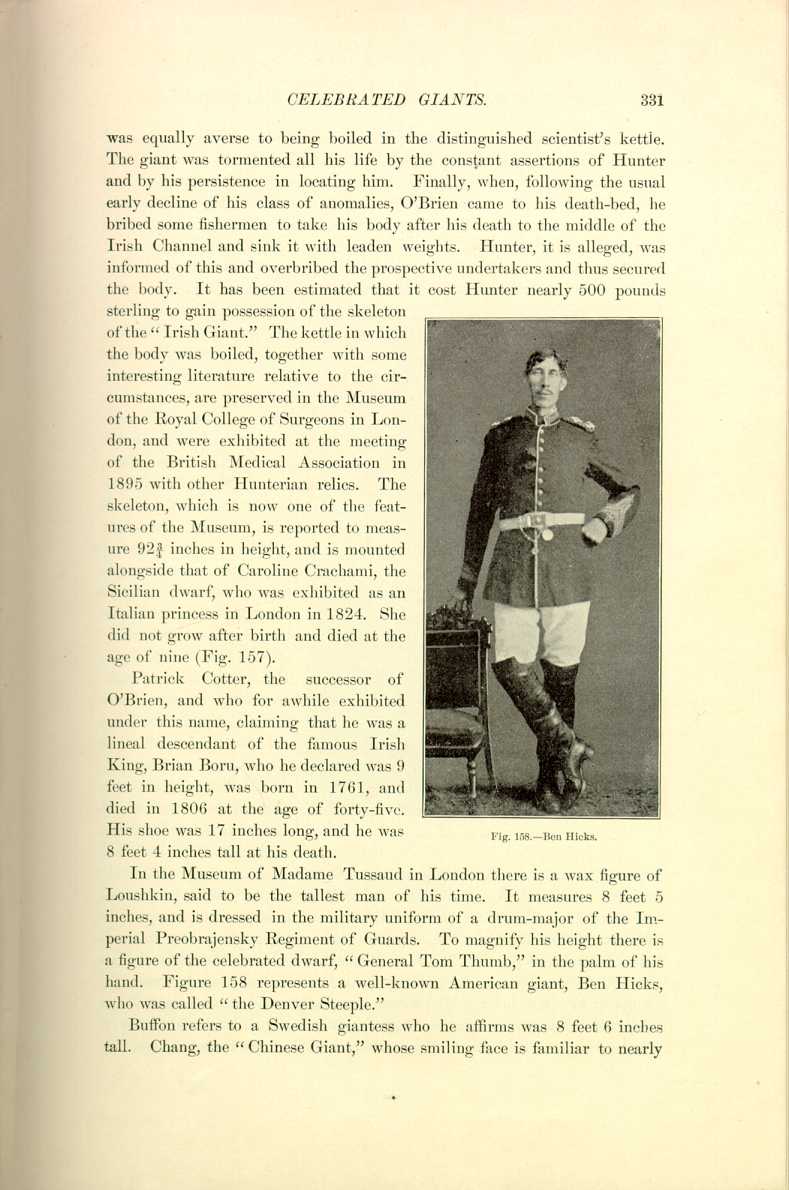
Fig. 158.—Ben Hicks.
[Description: Photograph of Ben Hicks, an American giant]
8 feet 4 inches tall at his death.
In the Museum of Madame Tussaud in London there is a wax figure of Loushkin, said to be the tallest man of his time. It measures 8 feet 5 inches, and is dressed in the military uniform of a drum-major of the Imperial Preobrajensky Regiment of Guards. To magnify his height there is a figure of the celebrated dwarf, "General Tom Thumb,'' in the palm of his hand. Figure 158 represents a well-known American giant, Ben Hicks who was called "the Denver Steeple.''
Buffon refers to a Swedish giantess who he affirms was 8 feet 6 inches tall. Chang, the "Chinese Giant,'' whose smiling face is familiar to nearly
On June 17, 1871, there were married at Saint-Martins-in-the-Field in London Captain Martin Van Buren Bates of Kentucky and Miss Anna Swann of Nova Scotia, two celebrated exhibitionists, both of whom were over 7 feet. Captain Bates, familiarly known as the "Kentucky Giant,'' years ago was a familiar figure in many Northern cities, where he exhibited himself in company with his wife, the combined height of the two being greater than that of any couple known to history. Captain Bates was born in Whitesburg, Letcher County, Ky., on November 9, 1845. He enlisted in the Southern army in 1861, and though only sixteen years old was admitted to the service because of his size. At the close of the war Captain Bates had attained his great height of 7 feet
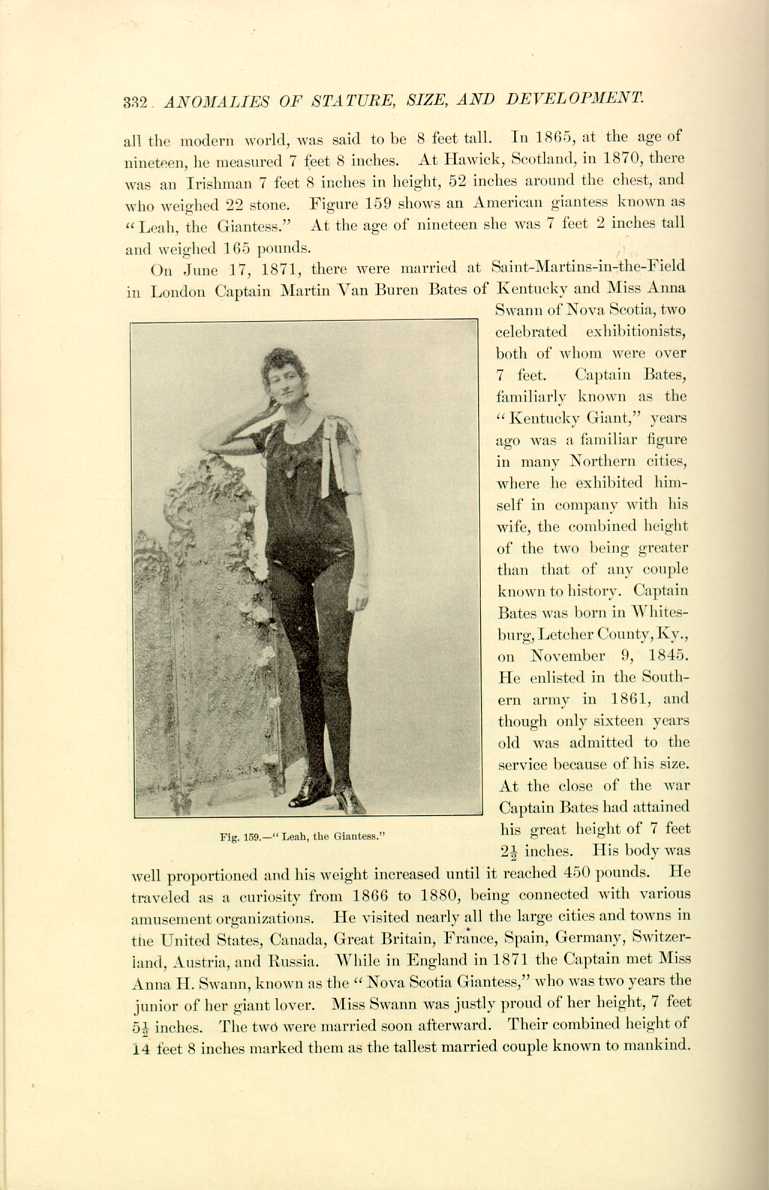
Fig. 159.—"Leah, the Giantess.''
[Description: Photograph of Leah, the Giantess]
2 1/2 inches. His body was well proportioned and his weight increased until it reached 450 pounds. He traveled as a curiosity from 1866 to 1880, being connected with various amusement organizations. He visited nearly all the large cities and towns in the United States, Canada, Great Britain, France, Spain, Germany, Switzerland, Austria, and Russia. While in England in 1871 the Captain met Miss Anna H. Swann, known as the "Nova Scotia Giantess,'' who was two years the junior of her giant lover. Miss Swann was justly proud of her height, 7 feet 5 1/2 inches. The two were married soon afterward. Their combined height of 14 feet 8 inches marked them as the tallest married couple known to mankind.
A recent newspaper dispatch says: "Captain M. V. Bates, whose remarkable height at one time attracted the attention of the world, has recently retired from his conspicuous position and lives in comparative obscurity on his farm in Guilford, Medina County, O., half a mile east of Seville.''
In 1845 there was shown in Paris Joachim Eleiceigui, the Spanish giant, who weighed 195 kilograms (429 pounds) and whose hands were 42 cm. (16 1/2 inches) long and of great beauty. In 1882 at the Alhambra in London there was a giantess by the name of Miss Marian, called the "Queen of the Amazons,'' aged eighteen years, who measured 2.45 meters (96 1/2 inches). William Campbell, a Scotchman, died at Newcastle in May 1878. He was so large that the window of the room in which the deceased lay and the brick-work to the level of the floor had to be taken out, in order that the coffin might be lowered with block and tackle three stories to the ground. On January 27, 1887, a Greek, although a Turkish subject, recently died of phthisis in Simferopol. He was 7 feet 8 inches in height and slept on three beds laid close together.
Giants of History.—A number of persons of great height, particularly sovereigns and warriors, are well-known characters of history, viz., William of Scotland, Edward III., Godefroy of Bouillon, Philip the Long, Fairfax, Moncey, Mortier, Kléber; there are others celebrated in modern times. Rochester, the favorite of Charles II.; Pothier, the jurist; Bank, the English naturalist; Gall, Billat-Savarin, Benjamin Constant, the painter David, Bellart, the geographer Delamarche, and Care, the founder of the Gentleman's Magazine, were all men of extraordinary stature.
Dwarfs.—The word "dwarf'' is of Saxon origin (dwerg, dweorg) and corresponds to the "pumilio'' or "nanus'' of the Romans. The Greeks believed in the pygmy people of Thrace and Pliny speaks of the Spithamiens. In the "Iliad'' Homer writes of the pygmies and Juvenal also describes them; but the fantasies of these poets have given these creatures such diminutive stature that they have deprived the traditions of credence. Herodotus relates that in the deserts of Lybia there were people of extreme shortness of stature. The Bible [7.7] mentions that no dwarf can officiate at the altar. Aristotle and Philostratus speak of pygmy people descended from Pygmæus, son of Dorus. In the seventeenth century van Helmont supposed that there were pygmies in the Canary Islands, and Abyssinia, Brazil, and Japan in the older times were repeatedly said to contain pygmy races. Relics
Dr. Schweinfurth, the distinguished African traveler, confirms the statements of Homer, Herodotus, and Aristotle that there was a race of pygmies near the source of the Nile. Schweinfurth says that they live south of the country occupied by the Niam-Niam, and that their stature varies from 4 feet to 4 feet 10 inches. These people are called the Akkas, and wonderful tales are told of their agility and cunning, characteristics that seem to compensate for their small stature.
In 1860 Paul DuChaillu speaks of the existence of an African people called the Obongos, inhabiting the country of the Ashangos, a little to the south of the equator, who were about 1.4 meters in height. There have been people found in the Esquimaux region of very diminutive stature. Battel discovered another pygmy people near the Obongo who are called the Dongos. Kolle describes the Kenkobs, who are but 3 to 4 feet high, and another tribe called the Reebas, who vary from 3 to 5 feet in height. The Portuguese speak of a race of dwarfs whom they call the Bakka-bakka, and of the Yogas, who inhabit territory as far as the Loango. Nubia has a tribe of dwarfs called the Sukus, but little is known of them. Throughout India there are stories of dwarf tribes descended from the monkey-God, or Hoonuman of the mythologic poems.
In the works of Humboldt and Burgoa there is allusion to the tradition of a race of pygmies in the unexplored region of Chiapas near the Isthmus of Tehuantepec in Central America. There is an expedition of anthropologists now on the way to discover this people. Professor Starr of Chicago on his return from this region reported many colonies of undersized people, but did not discover any pygmy tribes answering to the older legendary descriptions. Figure 160 represents two dwarf Cottas measuring 3 feet 6 inches in height.
The African pygmies who were sent to the King of Italy and shown in Rome resembled the pygmy travelers of Akka that Schweinfurth saw at the court of King Munza at Monbuttu. These two pygmies at Rome were found in Central Africa and were respectively about ten and fifteen years old. They spoke a dialect of their own and different from any known African tongue; they were partly understood by an Egyptian sergeant, a native of Soudan, who accompanied them as the sole survivor of the escort with which their donor, Miani, penetrated Monbuttu. Miani, like Livingstone, lost his life in African travel. These dwarfs had grown rapidly in recent years and at the time of report. measured 1.15 and 1.02 meters. In 1874 they were under the care of the Royal Geographical Society of Italy. They were intelligent in their manner, but resented being lionized too much, and were prone to scratch ladies who attempted to kiss them. [7.8]
It is known that at one time the ancients artificially produced dwarfs
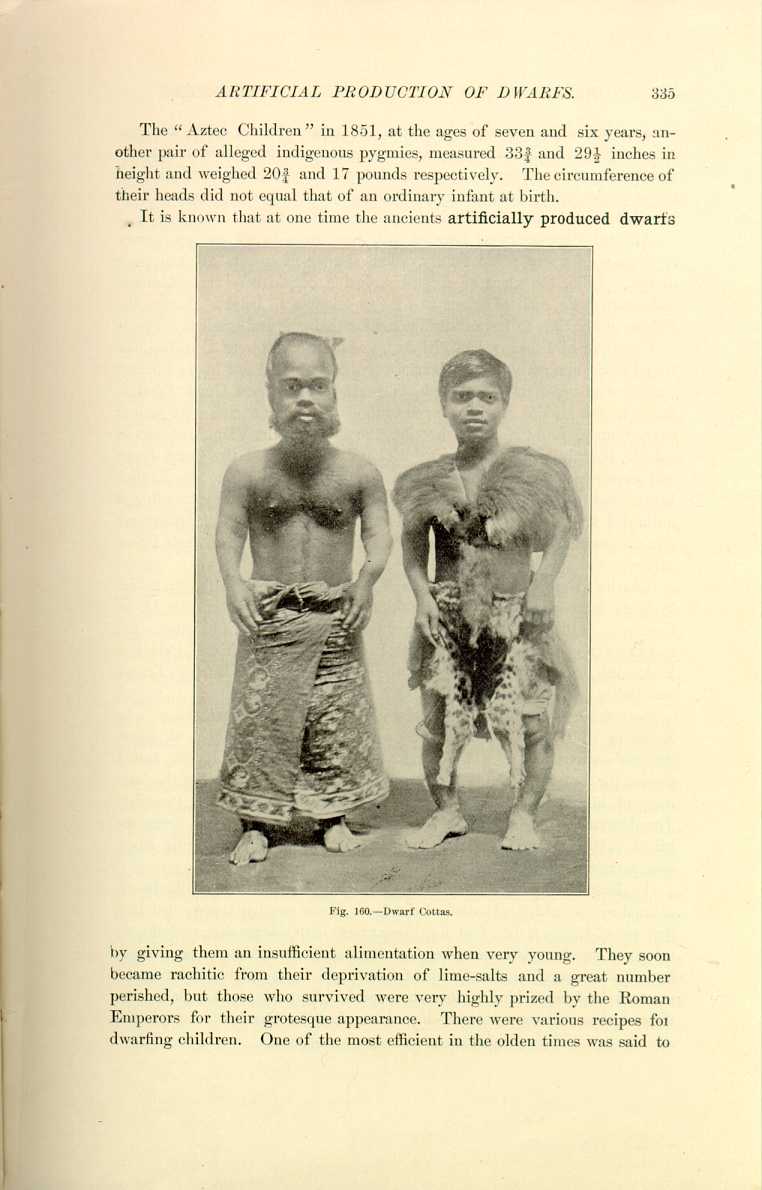
Fig. 160.—Dwarf Cottas.
[Description: Photograph of two dwarf Cottas]
by giving them an insufficient alimentation when very young. They soon became rachitic from their deprivation of lime-salts and a great number perished, but those who survived were very highly prized by the Roman Emperors for their grotesque appearance. There were various recipes for dwarfing children. One of the most efficient in the olden times was said to
Ancient Popularity of Dwarfs.—At one time a dwarf was a necessary appendage of every noble family. The Roman Emperors all had their dwarfs. Julia, the niece of Augustus, had a couple of dwarfs, Conopas and Andromeda, each of whom was 2 feet 4 inches in height. It was the fashion at one time to have dwarfs noted for their wit and wisdom. Philos of Cos, tutor of Ptolemy Philadelphus, was a dwarf, as were Carachus, the friend of Saladin; Alypius of Alexandria, who was only 2 feet high; Lucinus Calvus, who was only 3 feet high, and æsop, the famous Greek fabulist. Later in the Middle Ages and even to the last century dwarfs were seen at every Court. Lady Montagu describes the dwarfs at the Viennese Court as "devils bedaubed with diamonds.'' They had succeeded the Court Jester and exercised some parts of this ancient office. At this time the English ladies kept monkeys for their amusement. The Court dwarfs were allowed unlimited freedom of speech, and in order to get at truths other men were afraid to utter one of the Kings of Denmark made one of his dwarfs Prime Minister.
Charles IX. in 1572 had nine dwarfs, of which four had been given to him by King Sigismund-Augustus of Poland and three by Maximilian II. of Germany. Catherine de Médicis had three couples of dwarfs at one time, and in 1579 she had still five pygmies, named Merlin, Mandricart, Pelavine, Rodomont, and Majoski. Probably the last dwarf in the Court of France was Balthazar Simon, who died in 1662.
Sometimes many dwarfs were present at great and noble gatherings. In Rome in 1566 the Cardinal Vitelli gave a sumptuous banquet at which the table-attendants were 34 dwarfs. Peter the Great of Russia had a passion for dwarfs, and in 1710 gave a great celebration in honor of the marriage of his favorite, Valakoff, with the dwarf of the Princess Prescovie Theodorovna. There were 72 dwarfs of both sexes present to form the bridal party. Subsequently, on account of dangerous and difficult labor, such marriages were forbidden in Russia.
In England and in Spain the nobles had the portraits of their dwarfs painted by the celebrated artists of the day. Velasquez has represented Don Antonio el Inglès, a dwarf of fine appearance, with a large dog, probably to bring out the dwarf's inferior height. This artist also painted a great number of other dwarfs at the Court of Spain, and in one of his paintings he portrays the Infanta Marguerite accompanied by her male and female dwarfs. Reproductions of these portraits have been given by Garnier. [7.9] In the pictures
Intellectual Dwarfs.—It must be remarked, however, that many of the dwarfs before the public have been men of extraordinary-intelligence, possibly augmented by comparison. In a postmortem discussed at a meeting of the Natural History Society at Bonn in 1868 it was demonstrated by Schaufhausen that in a dwarf subject the brain weighed 1/19 of the body, in contradistinction to the average proportion of adults, from 1 to 30 to 1 to 44. The subject was a dwarf of sixty-one who died in Coblentz, and was said to have grown after his thirtieth year. His height was 2 feet 10 inches and his weight 45 pounds. The circumference of the head was 520 mm. and the brain weighed 1183.33 am. and was well convoluted. This case was one of simple arrest of development, affecting all the organs of the body; he was not virile. He was a child of large parents; had two brothers and a sister of ordinary size and two brothers dwarfs, one 6 inches higher and the other his size.
Several personages famous in history have been dwarfs. Attila, the historian Procopius, Gregory of Tours, Pépin le Bref, Charles III., King of Naples, and Albert the Grand were dwarfs. About the middle of the seventeenth century the French episcopacy possessed among its members a dwarf renowned for his intelligence. This diminutive man, called Godeau, made such a success in literature that by the grace of Richelieu he was named the Archbishop of Grasse. He died in 1672. The Dutch painter Doos, the English painter Gibson (who was about 3 feet in height and the father of nine infants by a wife of about the same height), Prince Eugene, and the Spanish Admiral Gravina were dwarfs. Fleury and Garry, the actors
Hay, a member of Parliament from Sussex in the last century; Hussein-Pasha, celebrated for his reforms under Selim III.; the Danish antiquarian and voyager, Arendt, and Baron Denon were men far below the average size Varro says that there were two gentlemen of Rome who from their decorations must have belonged to an Equestrian Order, and who were but 2 Roman cubits (about 3 feet) high. Pliny also speaks of them as preserved in their coffins.
It may be remarked that perhaps certain women are predisposed to give birth to dwarfs. Borwilaski had a brother and a sister who were dwarfs. In the middle of the seventeenth century a woman brought forth four dwarfs, and in the eighteenth century a dwarf named Hopkins had a sister as small as he was. Thèrése Souvray, the dwarf fiancée of Bébé, had a dwarf sister 41 inches high. Virey has examined a German dwarf of eight who was only 18 inches tall, i. e., about the length of a newly-born infant. The parents were of ordinary size, but had another child who was also a dwarf.
Celebrated Dwarfs.—Instances of some of the most celebrated dwarfs will be cited with a short descriptive mention of points of interest in their lives:—
Vladislas Cubitas, who was King of Poland in 1305, was a dwarf, and was noted for his intelligence, courage, and as a good soldier. Geoffrey Hudson, the most celebrated English dwarf, was born at Oakham in England in 1619. At the age of eight, when not much over a foot high, he was presented to Henriette Marie, wife of Charles I., in a pie; he afterward became her favorite. Until he was thirty he was said to be not more than 18 inches high, when he suddenly increased to about 45 inches. In his youth he fought several duels, one with a turkey cock, which is celebrated in the verse of Davenant. He became a popular and graceful courtier, and proved his bravery and allegiance to his sovereign by assuming command of a royalist company and doing good service therein. Both in moral and physical capacities he showed his superiority. At one time he was sent to France to secure a midwife for the Queen, who was a Frenchwoman. He afterward challenged a gentleman by the name of Croft to fight a duel, and would accept only deadly weapons; he shot his adversary in the chest; the quarrel grew out of his resentment of ridicule of his diminutive size. He was accused of participation in the Papist Plot and imprisoned by his political enemies in the Gate House at Westminster, where he died in 1682 at the advanced age of sixty-three. In Scott's "Peveril of the Peak'' Hudson figures prominently. This author seemed fond of dwarfs.
About the same epoch Charles I. had a page in his court named Richard Gibson, who was remarkable for his diminutive size and his ability as a miniature painter. This little artist espoused another of his class, Anne Shepherd, a dwarf of Queen Henriette Marie, about his size (45 inches). Mistress Gibson bore nine children, five of whom arrived at adult age and were of ordinary proportions. She died at the age of eighty; her husband afterward
In 1730 there was born of poor fisher parents at Jelst a child named Wybrand Lokes. He became a very skilful jeweler, and though he was of diminutive stature he married a woman of medium height, by whom he had several children. He was one of the smallest men ever exhibited, measuring but 25 1/2 inches in height. To support his family better, he abandoned his trade and with great success exhibited himself throughout Holland and England. After having amassed a great fortune he returned to his country, where he died in 1800, aged seventy. He was very intelligent, and proved his power of paternity, especially by one son, who at twenty-three was 5 feet 3 inches tall, and robust.
Another celebrated dwarf was Nicolas Ferry, otherwise known as Bébé. He was born at Plaine in the Vosges in 1741; he was but 22 cm. (8 1/2 inches) long, weighed 14 ounces at birth, and was carried on a plate to the church for baptism. At five Bébé was presented to King Stanislas of Poland. At fifteen he measured 29 inches. He was of good constitution, but was almost an idiot; for example, he did not recognize his mother after fifteen days' separation. He was quite lax in his morals, and exhibited no evidences of good nature except his lively attachment for his royal master, who was himself a detestable character. He died at twenty-two in a very decrepit condition, and his skeleton is preserved in the Museum of Natural History in Paris. Shortly before his death Bébé became engaged to a female dwarf named Thérèse Souvray, who at one time was exhibited in Paris at the Théâtre Conti, together with an older sister. Thérèse lived to be seventy-three, and both she and her sister measured only 30 inches in height. She died in 1819.
Aldrovandus *[116] gives a picture of a famous dwarf of the Duc de Créqui who was only 30 inches tall, though perfectly formed; he also speaks of some dwarfs who were not over 2 feet high.
There was a Polish gentleman named Joseph Borwilaski, born in 1739 who was famed all over Europe. He became quite a scholar, speaking French and German fairly well. In 1860, at the age of twenty-two, and 28 inches in height, he married a woman of ordinary stature, who bore him two infants well conformed. He was exhibited in many countries, and finally settled at Durham, England, where he died in 1837 at the almost incredible age of ninety-eight, and is buried by the side of the Falstaffian Stephen Kemble. Mary Jones of Shropshire, a dwarf 32 inches tall and much deformed, died in 1773 at the age of one hundred. These two instances are striking examples of great age in dwarfs and are therefore of much interest. Borwilaski's parents were tall in stature and three of his brothers were small; three of the other children measured 5 feet 6 inches. Diderot has written a history of this family.
At St. Philip's, Birmingham, there is the following inscription on a tomb: "In memory of Mannetta Stocker, who quitted this life on the 4th day of May, 1819, at the age of thirty-nine years, the smallest woman in the kingdom, and one of the most accomplished.'' She was born in Krauma, in the north of Austria, under normal conditions. Her growth stopped at the age of four, when she was 33 inches tall. She was shown in many villages and cities over Europe and Great Britain; she was very gay, played well on the piano, and had divers other accomplishments.
In 1742 there was shown in London a dwarf by the name of Robert Skinner, .63 meters in height, and his wife, Judith, who was a little larger. Their exhibition was a great success and they amassed a small fortune; during twenty-three years they had 14
robust and well-formed children. Judith died in 1763, and Robert grieved so much after her that he himself expired two years later.
Figure 161 shows a female dwarf with her husband and child, all of whom were exhibited some years since in the Eastern United States. The likeness of the child to the mother is already noticeable.
Buffon speaks of dwarfs 24, 21, and 18 inches high, and mentions one individual, aged thirty-seven, only 16 inches tall, whom he considers the smallest person on record. Virey in 1818 speaks of an English child of eight or nine who was but 18 inches tall. It had the intelligence of a child of three or four; its dentition was delayed until it was two years old and it did not walk until four. The parents of this child were of ordinary stature.
Rawdon [7.11] described a boy of five and a half, at the Liverpool Infirmary for Children, who weighed 10 1/2 pounds and whose height was 28 or 29 inches. He uttered no articulate sound, but evidently possessed the sense of hearing. His eyes were large and well formed, but he was apparently blind. He suckled, cut his teeth normally, but had tonic contractions of the spine and was an apparent idiot.
Hardie [7.12] mentions a girl of sixteen and a half whose height was 40 inches and
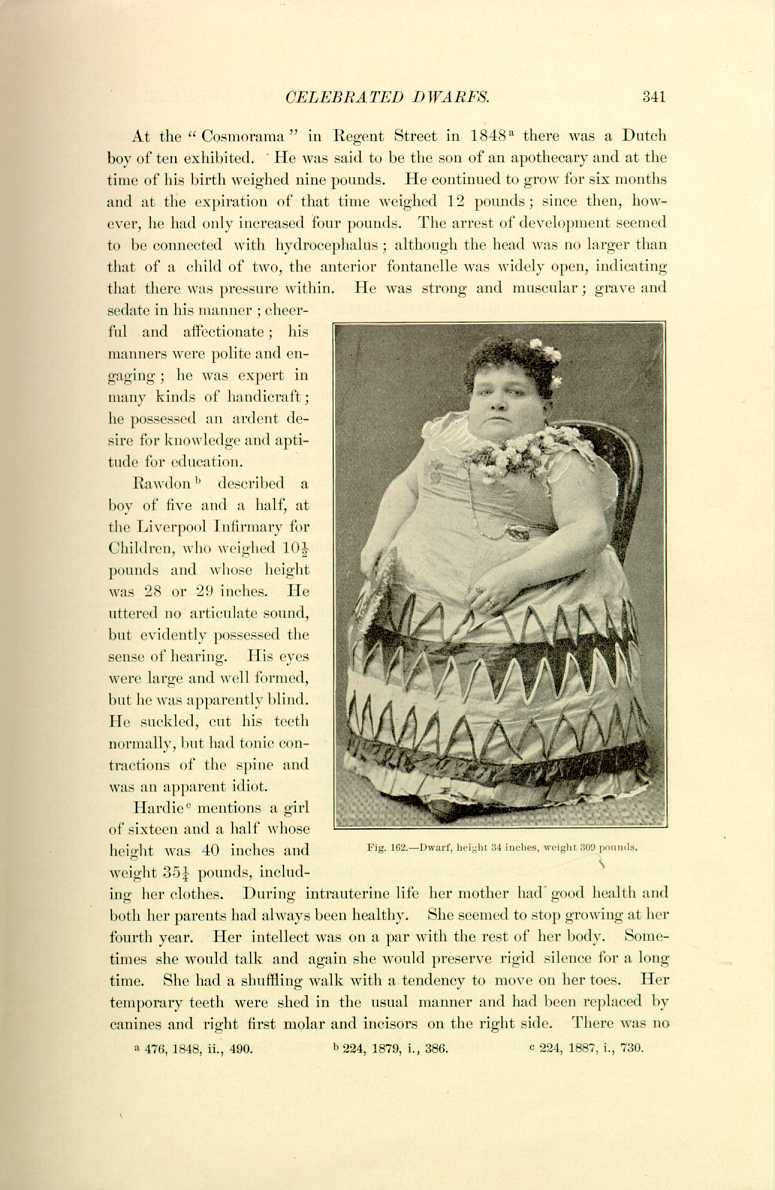
Fig. 169—Dwarf, height 34 inches, weight 309 pounds.
[Description: Photograph of female dwarf]
weight 35 1/2 pounds, including her clothes. During intrauterine life her mother had good health and both her parents had always been healthy. She seemed to stop growing at her fourth year. Her intellect was on a par with the rest of her body. Sometimes she would talk and again she would preserve rigid silence for a long time. She had a shuffling walk with a tendency to move on her toes. Her temporary teeth were shed in the usual manner and had been replaced by canines and right first molar and incisors on the right side. There was no
In recent years several dwarfs have commanded the popular attention, but none so much as "General Tom Thumb,'' the celebrated dwarf of Barnum's Circus. Charles Stratton, surnamed "Tom Thumb,'' was born at Bridgeport, Conn., on January 11, 1832; he was above the normal weight of the new-born. He ceased growing at about five months, when his height was less than 21 inches. Barnum, hearing of this phenomenon in his city, engaged him, and he was shown all over the world under his assumed name. He was presented to Queen Victoria in 1844, and in the following year he was received by the Royal Family in France. His success was wonderful, and even the most conservative journals described and commented on him. He gave concerts, in which he sang in a nasal voice; but his "drawing feat'' was embracing the women who visited him. It is said that in England alone he kissed a million females; he prided himself on his success in this function, although his features were anything but inviting.'' After he had received numerous presents and had amassed a large fortune he returned to America in 1864, bringing with him three other dwarfs, the "Sisters Warren'' and "Commodore Nutt.'' He married one of the Warrens, and by her had one child, Minnie, who died some months after birth of cerebral congestion. In 1883 Tom Thumb and his wife, Lavinia, were still living, but after that they dropped from public view and have since died.
In 1895 the wife of a dwarf named Morris gave birth to twins at Blaenavon, North Wales. Morris is only 35 inches in height and his wife is even smaller. They were married at Bartholmey Church and have since been traveling through England under the name of "General and Mrs. Small,'' being the smallest married couple in the world. At the latest reports the mother and her twins were doing well.
The Rossow Brothers have been recently exhibited to the public. These brothers, Franz and Carl, are twenty and eighteen years respectively. Franz is the eldest of 16 children and is said to weigh 24 pounds and measure 21 inches in height; Carl is said to weigh less than his brother but is 29 inches tall. They give a clever gymnastic exhibition and are apparently intelligent. They advertise that they were examined and still remain under the surveillance of the Faculty of Göttingen.
Next to the success of "Tom Thumb'' probably no like attraction has been so celebrated as the "Lilliputians,'' whose antics and wit so many Americans have in late years enjoyed. They were a troupe of singers and
The "Princess Topaze'' was born near Paris in 1879. According to a recent report she is perfectly formed and is intelligent and vivacious. She is 23 1/2 inches tall and weighs 14 pounds. Her parents were of normal stature.
Not long since the papers recorded the death of Lucia Zarete, a Mexican girl, whose exact proportions were never definitely known; but there is no doubt that she was the smallest midget ever exhibited In this country. Her exhibitor made a fortune with her and her salary was among the highest paid to modern "freaks.''
Miss H. Moritz, an American dwarf (Fig. 163), at the age of twenty weighed 36 pounds and was only 22 inches tall.
Precocious development is characterized by a hasty growth of the subject, who at an early period of life attains the dimensions of an adult. In some of these instances the anomaly is associated with precocious puberty, and after acquiring the adult growth at an early age there is an apparent cessation of the development.
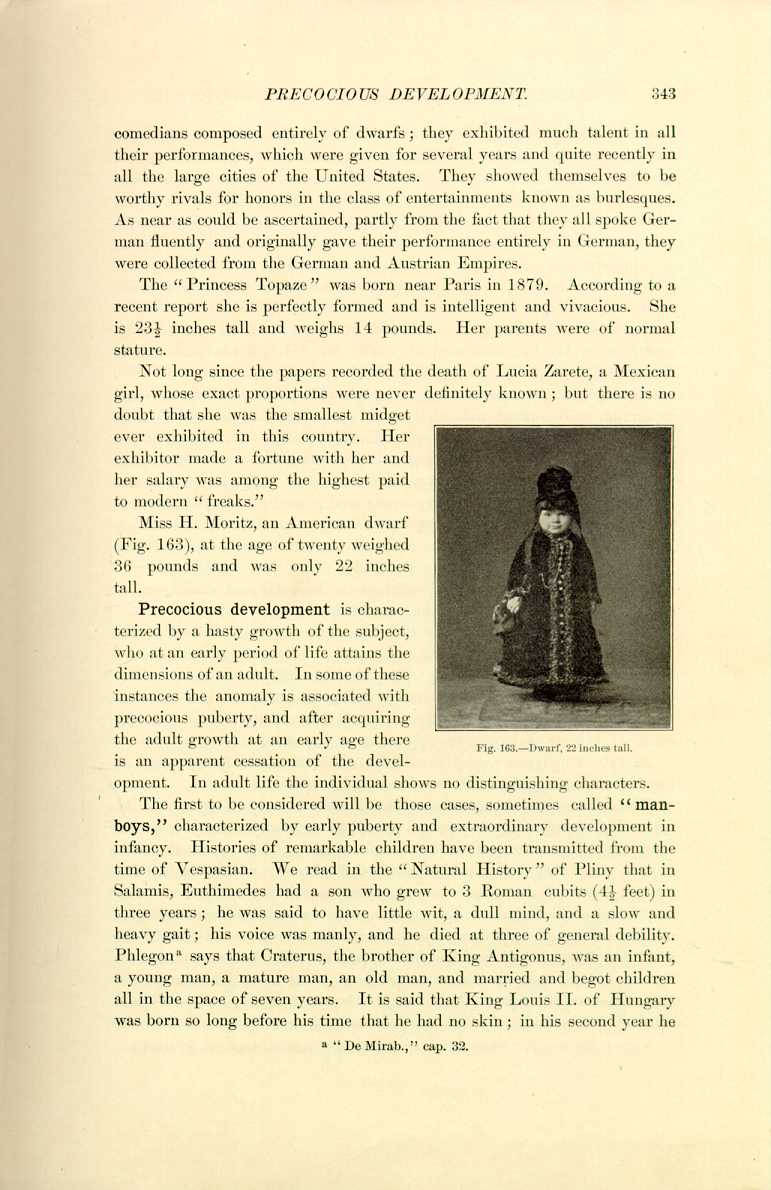
Fig. 163.—Dwarf, 22 inches tall.
[Description: Photograph of a female dwarf]
In adult life the individual shows no distinguishing characters.
The first to be considered will be those cases, sometimes called "man-boys,'' characterized by early puberty and extraordinary development in infancy. Histories of remarkable children have been transmitted from the time of Vespasian. We read in the "Natural History'' of Pliny that in Salamis, Euthimedes had a son who grew to 3 Roman cubits (4 1/2 feet) in three years; he was said to have little wit, a dull mind, and a slow and heavy gait; his voice was manly, and he died at three of general debility. Phlegon [7.13] says that Craterus, the brother of King Antigonus, was an infant, a young man, a mature man, an old man, and married and begot children all in the space of seven years. It is said that King Louis II. of Hungary was born so long before his time that he had no skin; in his second year he
It was said that Philip Howarth, who was born at Quebec Mews, Portman Square, London, February 21, 1806, lost his infantile rotundity of form and feature after the completion of his first year and became pale and extremely ugly, appearing like a growing boy. His penis and testes increased in size, his voice altered, and hair grew on the pubes. At the age of three he was 3 feet 4 1/2 inches tall and weighed 51 1/4 pounds. The length of his penis when erect was 4 1/2 inches and the circumference 4 inches; his thigh-measure was 13 1/2 inches, his waist-measure 24 inches, and his biceps 7 inches. He was reported to be clever, very strong, and muscular. An old chronicle says that in Wisnang Parish, village of Tellurge, near Tygure, in Lordship Kiburge, there was born on the 26th of May, 1548, a boy called Henry Walker, who at five years was of the height of a boy of fourteen and possessed the genitals of a man. He carried burdens, did men's work, and in every way assisted his parents, who were of usual size.
There is a case cited by the older authors [7.16] of a child born in the Jura region who at the age of four gave proof of his virility, at seven had a beard and the height of a man. The same journal also speaks of a boy of six, 1.62 meters tall, who was perfectly proportioned and had extraordinary strength. His beard and general appearance, together with the marks of puberty, gave him the appearance of a man of thirty.
In 1806 Dupuytren presented to the Medical Society in Paris a child 3 1/2 feet high, weighing 57 pounds, who had attained puberty.
There are on record six modern cases of early puberty in boys, *[666] one of whom died at five with the signs of premature senility; at one year he had shown signs of enlargement of the sexual organs. There was another who at three was 3 feet 6 3/4 inches high, weighed 50 pounds, and had seminal discharges. One of the cases was a child who at birth resembled an ordinary infant of five months. From four to fifteen months his penis enlarged, until at the age of three it measured when erect 3 inches. At this age he was 3 feet 7 inches high and weighed 64 pounds. The last case mentioned was an infant who experienced a change of voice at twelve months and showed hair on the pubes. At three years he was 3 feet 4 1/2 } inches tall and weighed 51 1/4 pounds. Smith, in Brewster's Journal, 1829, records the
Stone [7.18] gives an account of a boy of four who looked like a child of ten and exhibited the sexual organs of a man with a luxuriant growth of hair on the pubes. This child was said to have been of great beauty and a miniature model of an athlete. His height was 4 feet 1/4 inch and weight 70 pounds; the penis when semiflaccid was 4 1/4 inches long; he was intelligent and lively, and his back was covered with the acne of puberty. A peculiar fact as regards this case was the statement of the father that he himself had had sexual indulgence at eight. Stone parallels this case by several others that he has collected from medical literature. Breschet in 1821 reported the case of a boy born October 20, 1817, who at three years and one month was 3 feet 6 3/4 inches tall; his penis when flaccid measured 4 inches and when erect 5 1/4 inches, but the testicles were not developed in proportion. Lopez [7.19] describes a mulatto boy of three years ten and a half months whose height was 4 feet 1/2 inch and weight 82 pounds; he measured about the chest 27 1/2 inches and about the waist 27 inches; his penis at rest was 4 inches long and had a circumference of 3 1/2 inches, although the testes were not descended. He had evidences of a beard and his axillæ were very hairy; it is said he could with ease lift a man weighing 140 pounds. His body was covered with acne simplex and had a strong spermatic odor, but it was not known whether he had any venereal appetite.
Johnson [7.20] mentions a boy of seven with severe gonorrhea complicated with buboes which he had contracted from a servant girl with whom he slept. At the Hôpital des Enfans Malades children at the breast have been observed to masturbate. Fournier and others assert having seen infantile masturbators, and cite a case of a girl of four who was habitually addicted to masturbation from her infancy but was not detected until her fourth year; she died shortly afterward in a frightful state of marasmus. Vogel alludes to a girl of three in whom repeated attacks of epilepsy occurred after six months' onanism. Van Bambeke mentions three children from ten to twenty months old, two of them females, who masturbated.
Bidwell describes a boy of five years and two months who during the year previous had erections and seminal emissions. His voice had changed and he had a downy moustache on his upper lip and hair on the pubes; his
Pryor [7.21] speaks of a boy of three and a half who masturbated and who at five and a half had a penis of adult size, hair on the pubes, and was known to have had seminal emissions. Woods [7.22] describes a boy of six years and seven months who had the appearance of a youth of eighteen. He was 4 feet 9 inches tall and was quite muscular. He first exhibited signs of precocious growth at the beginning of his second year and when three years old he had hair on the pubes. There is an instance [7.23] in which a boy of thirteen had intercourse with a young woman at least a dozen times and succeeded in impregnating her. The same journal mentions an instance in which a boy of fourteen succeeded in impregnating a girl of the same age. Chevers *[266] speaks of a young boy in India who was sentenced to one year's imprisonment for raping a girl of three.
Douglass [7.24] describes a boy of four years and three months who was 3 feet 10 1/2 inches tall and weighed 54 pounds; his features were large and coarse, and his penis and testes were of the size of those of an adult. He was unusually dull, mentally, quite obstinate, and self-willed. It is said that he masturbated on all opportunities and had vigorous erections, although no spermatozoa were found in the semen issued. He showed no fondness for the opposite sex. The history of this rapid growth says that he was not unlike other children until the third year, when after wading in a small stream several hours he was taken with a violent chill, after which his voice began to change and his sexual organs to develop.
Blanc *[212] quotes the case described by Cozanet in 1875 of Louis Beran, who was born on September 29, 1869, at Saint-Gervais, of normal size. At the age of six months his dimensions and weight increased in an extraordinary fashion. At the age of six years he was 1.28 meters high (4 feet 2 1/3 inches) and weighed 80 pounds. His puberty was completely manifested in every way; he eschewed the society of children and helped his parents in their labors. Campbell [7.25] showed a lad of fourteen who had been under his observation for ten years. When fifteen months old this prodigy had hair on his pubes and his external genitals were abnormally larger end at the age of two years they were fully developed and had not materially changed in the following years. At times he manifested great sexual excitement. Between four and seven years he had seminal discharges, but it was not determined whether the semen contained spermatozoa. He had the muscular development of a man of twenty-five. He had shaved several years. The boy's education was defective from his failure to attend school.
The inscription on the tombstone of James Weir in the Parish of Carluke, Scotland, says that when only thirteen months old he measured 3 feet 4 inches in height and weighed 5 stone. He was pronounced by the faculty of Edinburgh and Glasgow to be the most extraordinary child of his age. Linnæus saw a boy at the Amsterdam Fair who at the age of three weighed 98 pounds. In Paris, about 1822, there was shown an infant Hercules of seven who was more remarkable for obesity than general development. He was 3 feet 4 inches high, 4 feet 5 inches in circumference, and weighed 220 pounds. He had prominent eyebrows, black eyes, and his complexion resembled that of a fat cook in the heat. Borellus *[841] details a description of a giant child. There is quoted from Boston [7.26] the report of a boy of fifteen months weighing 92 pounds who died at Coney Island. He was said to have been of phenomenal size from infancy and was exhibited in several museums during his life.
Desbois of Paris mentions an extraordinary instance of rapid growth in a boy of eleven who grew 6 inches in fifteen days.
Large and Small New-born Infants.—There are many accounts of new-born infants who were characterized
by their diminutive size. On page 66 we have mentioned Usher's instance of twins born at the one hundred and thirty-ninth day weighing each less than 11 ounces; Barker's case of a female child at the one hundred and fifty-eighth day weighing 1 pound; Newinton's case of twins at the fifth month, one weighing 1 pound and the other 1 pound 3 1/2 ounces; and on page 67 is an account of Eikam's five-months' child, weighing 8 ounces. Of full-term children Sir Everard
Scott [7.30] has recorded the birth of a child weighing 2 1/2 pounds, and another 3 1/4 pounds. In the Chicago Inter-Ocean there is a letter dated June 20, 1874, which says that Mrs. J. B. McCrum of Kalamazoo, Michigan, gave birth to a boy and girl that could be held in the palm of the hand of the nurse. Their aggregate weight was 3 pounds 4 ounces, one weighing 1 pound 8 ounces, the other 1 pound 12 ounces. They were less than 8 inches long and perfectly formed; they were not only alive but extremely vivacious.
There is an account [7.31] of female twins born in 1858 before term. One weighed 22 1/2 ounces, and over its arm, forearm, and hand one could easily pass a wedding-ring. The other weighed 24 ounces. They both lived to adult life; the larger married and was the mother of two children, which she bore easily. The other did not marry, and although not a dwarf, was under-sized; she had her catamenia every third week. Post [7.32] describes a 2-pound child.
On the other hand, there have been infants characterized by their enormous size at birth. Among the older writers, Cranz [7.33] describes an infant which at birth weighed 23 pounds; Fern [7.34] mentions a fetus of 18 pounds; and Mittehauser *[398] speaks of a new-born child weighing 24 pounds. Von Siebold in his "Lucina'' *[495] has recorded a fetus which weighed 22 1/2 pounds. It is worthy of comment that so great is the rarity of these instances that in 3600 cases, in the Rotunda Hospital, Dublin, only one child reached 11 pounds.
There was a child born in Sussex in 1869 [7.35] which weighed 13 1/2 pounds and measured 26 1/2 inches. Warren [7.36] delivered a woman in Derbyshire of male twins, one weighing 17 pounds 8 ounces and the other 18 pounds. The placenta weighed 4 pounds, and there was an ordinary pailful of liquor amnii. Both the twins were muscular and well formed; the parents were of ordinary stature, and at last reports the mother was rapidly convalescing. Burgess [7.37] mentions an 18-pound new-born child; end Meadows [7.38] has seen
Chubb [7.40] says that on Christmas Day, 1852, there was a child delivered weighing 21 pounds. The labor was not severe and the other children of the family were exceptionally large. Dickinson [7.41] describes a woman, a tertipara, who had a most difficult labor and bore an extremely large child. She had been thirty-six hours in parturition, and by evisceration and craniotomy was delivered of a child weighing 16 pounds. Her first child weighed 9 pounds, her second 20, and her third, the one described, cost her her life soon after delivery.
There is a history of a Swedish woman in Boston [7.42] who was delivered by the forceps of her first child, which weighed 19 3/4 pounds and which was 25 3/4 inches long. The circumference of the head was 16 3/4 inches, of the neck 9 3/4 , and of the thigh 10 3/4 inches.
Rice [7.43] speaks of a child weighing 20 1/4 pounds at birth. Johnston [7.44] describes a male infant who was born on November 26, 1848, weighing 20 pounds, and Smith [7.45] another of the same weight. Baldwin [7.46] quotes the case of a woman who after having three miscarriages at last had a child that weighed 23 pounds. In the delivery there was extensive laceration of the anterior wall of the vagina; the cervix and perineum, together with an inch of the rectum, were completely destroyed.
Beach [7.47] describes a birth of a young giant weighing 23 3/4 pounds. Its mother was Mrs. Bates, formerly Anna Swann, the giantess who married Captain Bates. Labor was rather slow, but she was successfully delivered of a healthy child weighing 23 3/4 pounds and 30 inches long. The secundines weighed ten pounds and there were nine quarts of amniotic fluid.
There is a recent record [7.48] of a Cesarian section performed on a woman of forty in her twelfth pregnancy and one month beyond term. The fetus, which was almost exsanguinated by amputation, weighed 22 1/2 pounds. Bumm [7.49] speaks of the birth of a premature male infant weighing 4320 gm. (9 1/2 pounds) and measuring 54 cm. long. Artificial labor had been induced at the thirty-fifth week in the hope of delivering a living child, the three preceding infants having all been still-born on account of their large size. Although the mother's pelvis was wide, the disposition to bear huge infants was so great as to render the woman virtually barren.
Finlayson [7.50] reports a case of a child affected with congenital unilateral hypertrophy associated with patches of cutaneous congestion. Logan [7.51] mentions
hypertrophy in the right half of the body in a child of four, first noticed shortly after birth; Langlet [7.52] also speaks of a case of congenital hypertrophy of the right side. Broca [7.53] and Trélat [7.54] were among the first observers to discuss this anomaly.
Tilanus of Munich in 1893 reported a case of hemihypertrophy in a girl of ten. The whole right half of the body was much smaller and better developed than the left, resulting in a limping gait. The electric reaction
Adams [7.55] reports an unusual case of hemihypertrophy in a boy of ten. There was nothing noteworthy in the family history, and the patient had suffered from none of the diseases of childhood. Deformity was noticeable at birth, but not to such a degree relatively as at a later period. The increased growth affected the entire right half of the body, including the face, but was most noticeable in the leg, thigh, and buttock. Numerous telangiectatic
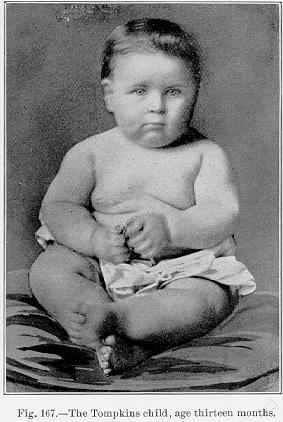
Fig. 167.—The Tompkins child, age thirteen months.
[Description: Photograph of the Tompkins child]
spots were scattered irregularly over the body, but most thickly on the right side, especially on the outer surface of the leg. The accompanying illustration (Fig. 165) represents the child's appearance at the time of report.
Jacobson [7.56] reports the history of a female child of three years with nearly universal giant growth (Riesenwuchs). At first this case was erroneously diagnosed as acromegaly. The hypertrophy affected the face, the genitals, the left side of the trunk, and all the limbs.
Milne [7.57] records a case of hemihypertrophy in a female child of one year
Obesity.—The abnormality of the adipose system, causing in consequence an augmentation of the natural volume of the subject, should be described with other anomalies of size and stature. Obesity may be partial, as seen in the mammæ or in the abdomen of both women and men, or it may be general; and
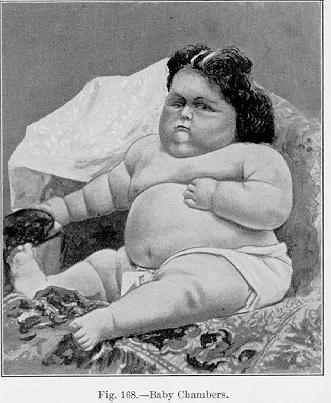
Fig. 168.—Baby Chambers.
[Description: Photograph of Baby Chambers]
it is of general obesity that we shall chiefly deal. Lipomata, being distinctly pathologic formations, will be left for another chapter.
The cases of obesity in infancy and childhood are of considerable interest, and we sometimes see cases that have been termed examples of "congenital corpulency.'' Figure 167 represents a baby of thirteen months that weighed 75 pounds. Figure 168 shows another example of infantile obesity, known as "Baby Chambers.'' Elliotson *[322] describes a female infant not a year old which weighed 60 pounds. There is an instance on record of a girl of four who weighed 256 pounds [7.59] Tulpius [7.60] mentions a girl of five who weighed 150 pounds and had the strength of a man. He says that the
Bartholinus mentions a girl of eleven who weighed over 200 pounds. There is an instance recorded of a young girl in Russia who weighed nearly 200 pounds when but twelve. Wulf, quoted by Ebstein, describes a child which died at birth weighing 295 ounces. It was well proportioned and looked like a child three months old, except that it had an enormous development of fatty tissue. The parents were not excessively large, and the mother stated that she had had children before of the same proportions. Grisolles [7.61] mentions a child who was so fat at twelve months that there was constant danger of suffocation; but, marvelous to relate, it lost all its obesity when two and a half, and later was remarkable for its slender figure. Figure 169 shows a girl born in Carbon County, Pa., who weighed 201 pounds when nine years old. McNaughton [7.62] describes Susanna Tripp, who at six years of age weighed 203 pounds and was 3 feet 6 inches tall and measured 4 feet 2 inches around the waist. Her younger sister, Deborah, weighed 119 pounds; neither of the two weighed over 7 pounds at birth and both began to grow at the fourth month. On October, 1788, there died at an inn in the city of York the surprising "Worcestershire Girl'' at the age of five. She had an exceedingly beautiful face and was quite active. She was 4 feet in height and larger around the breast and waist; her thigh measured 18 inches and she weighed nearly 200 pounds. In February, 1814, Mr. S. Pauton was married to the only daughter of Thomas Allanty of Yorkshire; although she was but thirteen she was 13 stone weight (182 pounds). At seven years she had weighed 7 stone (98 pounds). Williams *[787] mentions several instances of fat children. The first was a German girl who at birth weighed 13 pounds; at six months, 42 pounds; at four years, 150 pounds; and at twenty years, 450 pounds. Isaac Butterfield, born near Leeds in 1781, weighed 100 pounds in 1782 and was 3 feet 13 inches tall. There was a child named Everitt, exhibited in London in 1780, who at eleven months was 3 feet 9 inches tall and measured around the loins over 3 feet. William Abernethy [7.63] at the age of thirteen weighed 22 stone (308 pounds) and measured 57 inches around the waist. He was 5 feet 6 inches tall. There was a girl of ten [7.64] who was 1.45 meters (4 feet 9 inches) high and weighed 175 pounds. Her manners were infantile and her intellectual development
At a meeting of the Physical Society of Vienna on December 4, 1894, [7.65] there was shown n girl of five and a half who weighed 250 pounds. She was just shedding her first teeth; owing to the excess of fat on her short limbs she toddled like an infant. There was no tendency to obesity in her family. Up to the eleventh month she was nursed by her mother, and subsequently
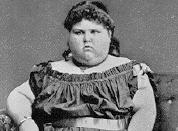
Fig. 169.—Age nine, weight 201 pounds.
[Description: Photograph of girl weighing 201 pounds]
fed on cabbage, milk, and vegetable soup. This child, who was of Russian descent, was said never to perspire.
Cameron [7.66] describes a child who at birth weighed 14 pounds, at twelve months she weighed 69 pounds, and at seventeen months 98 pounds. She was not weaned until two years old and she then commenced to walk. The parents were not remarkably large. There is an instance of a boy of thirteen and a half who weighed 214 pounds. [7.67] Kaestner speaks of a child of four
Figure 170 represents Miss "Millie Josephine'' of Chicago, a recent exhibitionist,
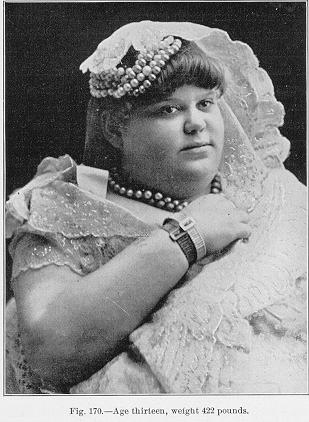
Fig. 170—Age thirteen, weight 422 pounds.
[Description: Photograph of girl weighing 422 pounds]
who at the reputed age of thirteen was 5 feet 6 inches tall and weighed 422 pounds.
General Remarks.—It has been chiefly in Great Britain and in Holland that the most remarkable instances of obesity have been seen, especially in the former country colossal weights have been recorded. In some countries corpulency has been considered an adornment of the female sex. Hesse-Wartegg [7.70] refers to the Jewesses of Tunis, who when scarcely ten years old are subjected to systematic treatment by confinement in narrow, dark rooms, where they are fed on farinaceous foods and the flesh of young puppies until
In some nations and families obesity is hereditary, and generations come and go without a change in the ordinary conformation of the representatives. In other people slenderness is equally persistent, and efforts to overcome this peculiarity of nature are without avail.
Treatment of Obesity.—Many persons, the most famous of whom was Banting, have advanced theories to reduce corpulency and to improve slenderness; but they have been uniformly unreliable, and the whole subject of stature-development presents an almost unexplored field for investigation. Recently, Leichtenstein, [7.71] observing in a case of myxedema treated with the thyroid gland that the subcutaneous fat disappeared with the continuance of the treatment, was led to adopt this treatment for obesity itself and reports striking results. The diet of the patient remained the same, and as the appetite was not diminished by the treatment the loss of weight was evidently due to other causes than altered alimentation. He holds that the observations in myxedema, in obesity, and psoriasis warrant the belief that the thyroid gland eliminates a material having a regulating influence upon the constitution of the panniculus adiposus and upon the nutrition of the skin in general. There were 25 patients in all; in 22 the effect was entirely satisfactory, the loss of weight amounting to as much as 9.5 kilos (21 pounds). Of the three cases in which the result was not satisfactory, one had nephritis with severe Graves' disease, and the third psoriasis. Charrin [7.72] has used the injections of thyroid extract with decided benefit. So soon as the administration of the remedy was stopped the loss of weight ceased, but with the renewal of the remedy the loss of weight again ensued to a certain point, beyond which the extract seemed powerless to act. Ewald also reports good results from this treatment of obesity.
Remarkable Instances of Obesity.—From time immemorial fat men and women have been the object of curiosity and the number who have exhibited themselves is incalculable. Nearly every circus and dime museum has its example, and some of the most famous have in this way been able to accumulate fortunes.
Athenæus [7.73] has written quite a long discourse on persons of note who in the olden times were distinguished for their obesity. He quotes a description of Denys, the tyrant of Heraclea, who was so enormous that he was in constant danger of suffocation; most of the time he was in a stupor or asleep, a peculiarity of very fat people. His doctors had needles put in the back of his chairs to keep him from falling asleep when sitting up and thus incurring the danger of suffocation. In the same work Athenæus [7.74] speaks of
According to old chronicles the cavaliers at Rome who grew fat were condemned to lose their horses and were placed in retirement. During the Middle Ages, according to Guillaume in his "Vie de Suger,'' obesity was considered a grace of God.
Among the prominent people in the olden time noted for their embonpoint were Agesilas, the orator C. Licinius Calvus, who several times opposed Cicero, the actor Lucius, and others. Among men of more modern times we can mention William the Conqueror; Charles le Gros; Louis le Gros; Humbert II., Count of Maurienne; Henry I., King of Navarre; Henry III., Count of Champagne; Conan III., Duke of Brittany; Sancho I., King of Leon; Alphonse II., King of Portugal; the Italian poet Bruni, who died in 1635; Vivonne, a general under Louis XIV.; the celebrated German botanist Dillenius; Haller; Frederick I., King of Würtemberg, and Louis XVIII.
Probably the most famous of all the fat men was Daniel Lambert, born March 13, 1770, in the parish of Saint Margaret, Leicester. He did not differ from other youths until fourteen. He started to learn the trade of a die-sinker and engraver in Birmingham. At about nineteen he began to believe he would be very heavy and developed great strength. He could lift 500 pounds with ease and could kick seven feet high while standing on one leg. In 1793 he weighed 448 pounds; at this time he became sensitive as to his appearance. In June, 1809, he weighed 52 stone 11 pounds (739 pounds), and measured over 3 yards around the body and over 1 yard around the leg. He had many visitors, and it is said that once, when the dwarf Borwilaski came to see him, he asked the little man how much cloth he needed for a suit. When told about 3/4 of a yard, he replied that one of his sleeves would be ample. Another famous fat man was Edward Bright, sometimes called "the fat man of Essex.'' He weighed 616 pounds. [7.75] In the same journal that records Bright's weight is an account of a man exhibited in Holland who weighed 503 pounds.
Wadd, a physician, himself an enormous man, wrote a treatise on obesity and used his own portrait for a frontispiece. He speaks of Doctor Beddoes, who was so uncomfortably fat that a lady of Clifton called him a "walking feather bed.'' He mentions Doctor Stafford, who was so enormous that this epitaph was ascribed to him:—
For here lies Dr. Stafford, in all this churchyard.''
Wadd has gathered some instances, a few of which will be cited. At
Mr. Spooner, an eminent farmer of Warwickshire, who died in 1775, aged fifty-seven, weighed 569 pounds and measured over 4 feet across the shoulders. The two brothers Stoneclift of Halifax, Yorkshire, together weighed 980 pounds. [7.77]
Keysler in his travels speaks of a corpulent Englishman who in passing through Savoy had to use 12 chairmen; he says that the man weighed 550 pounds. It is recorded on the tombstone of James Parsons, a fat man of Teddington, who died March 7, 1743, that he had often eaten a whole shoulder of mutton and a peck of hasty pudding. Keysler mentions a young Englishman living in Lincoln who was accustomed to eat 18 pounds of meat daily. He died in 1724 at the age of twenty-eight, weighing 530 pounds. In 1815 there died in Trenaw, in Cornwall, a person known as "Giant Chillcot.'' He measured at the breast 6 feet 9 inches and weighed 460 pounds. One of his stockings held 6 gallons of wheat. In 1822 there was reported to be a Cambridge student who could not go out in the daytime without exciting astonishment. The fat of his legs overhung his shoes like the fat in the legs of Lambert and Bright. Dr. Short mentions a lady who died of corpulency in her twenty-fifth year weighing over 50 stone (700 pounds). Catesby speaks of a man who weighed 500 pounds, [7.78] and Coe mentions another who weighed 584 pounds. [7.79] Fabricius and Godart speak of obesity so excessive as to cause death. There is a case reported from the French of a person who weighed 800 pounds. [7.80] Smetius [7.81] speaks of George Fredericus, an office-holder in Brandenburgh, who weighed 427 pounds.
Dupuytren [7.82] gives the history of Marie Françoise-Clay, who attained such celebrity for her obesity. She was born in poverty, reached puberty at thirteen, and married at twenty-five, at which age she was already the stoutest woman of her neighborhood notwithstanding her infirmity. She followed her husband, who was an old-clothes dealer, afoot from town to town. She bore six children, in whom nothing extraordinary was noticed. The last one was born when she was thirty-five years old. Neither the births, her travels, nor her poverty, which sometimes forced her to beg at church doors, arrested the progress of the obesity. At the age of forty she was 5 feet 1 inch high and one inch greater about the waist. Her head was small and her neck was entirely obliterated. Her breasts were over a yard in circumference and
Fournier [7.83] quotes an instance of a woman in Paris who at twenty-four, the time of her death, weighed 486 pounds. Not being able to mount any conveyance or carriage in the city, she walked from place to place, finding difficulty not in progression, but in keeping her equilibrium. Roger Byrne, who lived in Rosenalis, Queen's County, Ireland, died of excessive fatness at the age of fifty-four, weighing 52 stone. Percy and Laurent speak of a young German of twenty who weighed 450 pounds. At birth he weighed 13 pounds, at six months 42, and at four years 150 pounds. He was 5 feet 5 inches tall and the same in circumference. William Campbell, the landlord of the Duke of Wellington in Newcastle-on-Tyne, was 6 feet 4 inches tall and weighed 728 pounds. He measured 96 inches around the shoulders, 85 inches around the waist, and 35 inches around the calf. He was born at Glasgow in 1856, and was not quite twenty-two when last measured. To illustrate the rate of augmentation, he weighed 4 stone at nine months and at ten years 18 stone. He was one of a family of seven children. His appetite was not more than the average, and he was moderate as regards the use of liquors, but a great smoker Notwithstanding his corpulency, he was intelligent and affable. [7.84]
Miss Conley, a member of an American traveling circus, who weighed 479 pounds, [7.85] was smothered in bed by rolling over on her face; she was unable to turn on her back without assistance.
There was a girl who died at Plaisance near Paris in 1890 who weighed 470 pounds or more. In 1889 an impresario undertook to exhibit her; but eight men could not move her from her room, and as she could not pass through the door the idea was abandoned. [7.86]
There was a colored woman who died near Baltimore [7.87] who weighed 850 pounds, exceeding the great Daniel Lambert by 120 pounds. The journal reporting this case quotes the Medical Record as saying that there was a man in North Carolina, who was born in 1798, who was 7 feet 8 inches tall and weighed over 1000 pounds, probably the largest man that ever lived. Hutchison [7.88] says that he Saw in the Infirmary at Kensington, under Porter's care, a remarkable example of obesity. The woman was only just able to walk about and presented a close resemblance to Daniel Lambert. Obesity forced her to leave her occupation. The accumulation of fat on the abdomen, back, and thighs was enormous.
According to a recent number of La Liberté, a young woman of Pennsylvania,
Simulation of Obesity.— General dropsy, elephantiasis, lipomata, myxedema, and various other affections in which there is a hypertrophic change of the connective tissues may be mistaken for general obesity; on the other hand, a fatty, pendulous abdomen may simulate the appearances of pregnancy or even of ovarian cyst (Fig. 172).
Dercum of Philadelphia [7.89] has described a variety of obesity
which he has called "adiposis dolorosa,'' in which there is an enormous growth of fat, sometimes limited, sometimes spread all over the body, this condition differing from that of general lipomatosis in its rarity, in the mental symptoms, in the headache, and the generally painful condition complained of. In some of the cases examined by Dercum he found that the thyroid was indurated and infiltrated by calcareous deposits. The disease is not myxedema because there is no peculiar physiognomy, no spade-like hands nor infiltrated skin, no alteration of the speech, etc. Dercum considers it a connective-tissue dystrophy—a fatty metamorphosis of various stages, possibly a neuritis. The first of Dercum's cases (Fig. 173) was a widow of Irish birth, who died
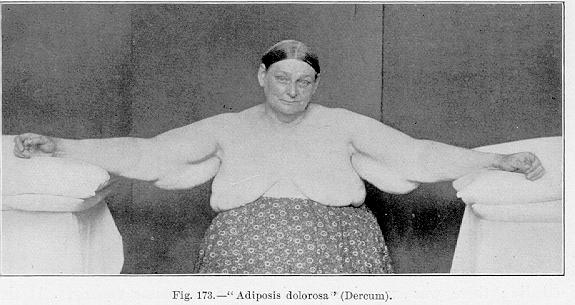
Fig. 173.—"Adiposis dolorosa' (Dercum).
[Description: Photograph of woman with "adiposis dolorosa"]
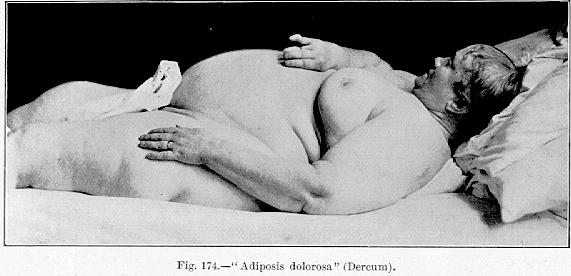
Fig. 174.—"Adiposis dolotosa'' (Dercum).
[Description: Photograph of woman lying down]
arms, back, and sides of the chest. The parts affected were elastic, and there was no pitting. In some places the fat was lobulated, in others it appeared as though filled with bundles of worms. The skin was not thickened and the muscles were not involved. In the right arm there was unendurable pain to the touch, and this was present in a lesser degree in the left arm. Cutaneous sensibility was lessened. On June 13th a chill was followed by herpes over the left arm and chest, and later on the back and on the front of the chest. The temperature was normal. The second case was a married Englishwoman of sixty-four (Fig. 174). The enlarged tissue was very unevenly distributed, and sensibility was the same as in the previous case. At the woman's death she weighed 300 pounds, and the fat over the abdomen was three inches thick. The third case was a German woman in whom were seen soft, fat-like masses in various situations over either biceps, over the outer and posterior aspect of either arm, and two large masses over
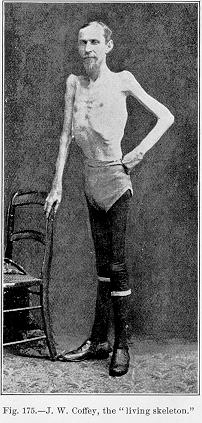
Fig 175.—J. W. Coffey, the "living skeleton.''
[Description: Photograph of J. W. Coffey, standing]
the belly; there was excessive prominence of the mons veneris. At the
Abnormal Leanness.—In contrast to the fat men are the so-called "living skeletons,'' or men who have attained notice by reason of absence of the
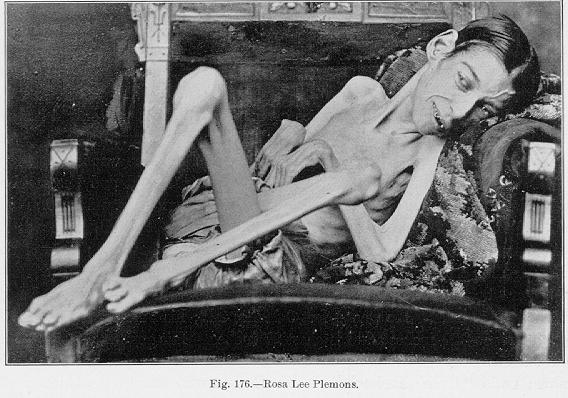
Fig. 176.—Rosa Lee Plemons.
[Description: Photograph of Rosa Lee Plemons]
normal adipose tissue. The semimythical poet Philotus was so thin that it was said that he fastened lead on his shoes to prevent his being blown away,— a condition the opposite of that of Dionysius of Heraclea, who, after choking to death from his fat, could hardly be moved to his grave.
In March, 1754, there died in Glamorganshire of mere old age and gradual decay a little Welshman, Hopkin Hopkins, aged seventeen years. He had been recently exhibited in London as a natural curiosity; he had never weighed over 17 pounds, and for the last three years of his life never more
There was a "living skeleton'' brought to England in 1825 by the name of Claude Seurat. He was born in 1798 and was in his twenty-seventh year. He usually ate in the course of a day a penny roll and drank a small quantity of wine. His skeleton was plainly visible, over which the skin was stretched tightly. The distance from the chest to the spine was less than 3 inches, and internally this distance was less. The pulsations of the heart were plainly visible. He was in good health and slept well. His voice was very weak and shrill. The circumference of this man's biceps was only 4 inches. The artist Cruikshank has made several drawings of Seurat.
Calvin Edson was another living skeleton. In 1813 he was in the army at the battle of Plattsburg, and had lain down in the cold and become benumbed. At this time he weighed 125 pounds and was twenty-five years old. In 1830 he weighed but 60 pounds, though 5 feet 4 inches tall. He was in perfect health and could chop a cord of wood without fatigue; he was the father of four children.
Salter [7.91] speaks of a man in 1873 who was thirty-two years of age and only weighed 49 pounds. He was 4 feet 6 inches tall: his forehead measured in circumference 20 1/2 inches and his chest 27 inches. His genitals, both internal and external, were defectively developed. Figure 175 represents the well-known Ohio "living skeleton,'' J. W. Coffey, who has been exhibited all over the Continent. His good health and appetite were proverbial among his acquaintances.
In some instances the so-called "living skeletons'' are merely cases of extreme muscular atrophy. As a prominent example of this class the exhibitionist, Rosa Lee Plemons (Fig. 176) at the age of eighteen weighed only 27 pounds. Figure 177 shows another case of extraordinary atrophic condition of all the tissues of the body associated with nondevelopment. These persons are always sickly and exhibit all the symptoms of progressive muscular atrophy, and cannot therefore be classed with the true examples of thinness, in which the health is but slightly affected or possibly perfect health is enjoyed.
| CHAPTER VII.
ANOMALIES OF STATURE, SIZE, AND
DEVELOPMENT. Anomalies and Curiosities of Medicine | ||
